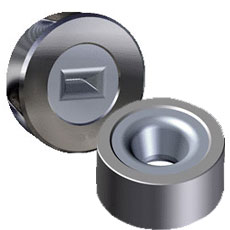
Carbide tooling is necessary for any cold forming, cold heading or extrusion process. Basically carbide tooling consists of anything that assists in the forming process besides the carbide dies. They are used to pound slugs into dies, cut off wires at set lengths and anything else that requires a durable part that can stand up to the punishing action of cold forming and heading. Tungsten carbide is used for this kind of tooling due to its extreme hardness and durability. In fact carbide tooling last four times longer than comparable steel tooling and this means less down time for machines and changing tooling out less frequently. In the long (or short) run, this means greater efficiency and profit.
A commonly used example of carbide tooling is a punch. Carbide punches have the punishing task of being slammed into metal slugs with enough force to cause them to form to the shape of a carbide die. Obviously this is one area where you don’t want to employ a weaker part! Think of carbide punches like the head of a hammer.
Another place where you will find carbide tooling used in the cold forming process is at the other end of carbide dies. Wire is created by forcing material through a drawing die, once through the draw die a piece of carbide tooling called a cut-off knife is used to cut the wire to length. Carbide cut-off knives can be employed anywhere where tough cuts are needed, and cutting wire will dull any edge quickly so once again carbide is used do to its hardness.
Carbide tooling obviously wears down during usage and eventually has to be replaced. How long it lasts depends on how much pressure the tools are under and the material they are being used to form. Cold forming steal will wear out tooling at a much faster rate than cold forming copper for example. Companies can often save money by sending their tooling to carbide die companies to be reworked. This will extend the life of the carbide tooling and it’s a lot cheaper then replacing tools every time they wear out.
Here’s a list of examples of carbide tooling.
• Nibs• Cut-Off Knives• Mandrels• Punches• Quills• Inserts• Annular Rings• Bushings
• Bearings• Shafts
• Bearings• Shafts



